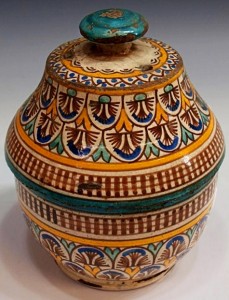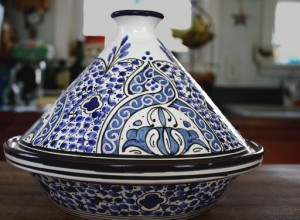Morocco’s pottery and ceramics are one of the real treasures of the souks with diverse traditional and modern colors and designs influenced by Berber and Islamic art and before them, absorbing Phoenician, Roman and Byzantine designs. Ceramics and pottery pieces include vases, plates, pots, dishes, bowls, and the funnel shaped tangines used for slow cooking stews. Be sure to distinguish pottery used for cooking from ceramics used for decoration, because the glazes used to fix colors include lead and cadmium. It is not unusual for there to be several glazing and several firings on a particular Moroccan piece. The final product is vividly decorated and water-resistant due to the glaze.
Artisans carry on centuries-old traditions in their designs are passed on through families. The three main pottery centers are Safi, Fes and Meknes. Safi is by the far the largest production center where apprentice workers kneed the clay and skilled artisans create the shapes out of the sun baked clay on the potter’s wheel. Designs are etched on the wet clay and dried in the sun. They are then fired in kilns to evaporate the moisture from the clay, cooled and then decorated with colored glazes which make them water resistant. Pottery from Safi is known for its metal inlays and is often made of red clay and glazed in green, turquoise and black.
Potters throughout Morocco also use modern multicolored designs as well as traditional patterns. If you visit Safi you will find the Quartier des Potiers or Potters’ Quarter near the Portuguese fortifications known as the Kechla and the National Ceramic Museum, which is in the Kechla. It displays the typical pottery styles throughout the country, and, from the walls of the fort, you can see the potters’ hill, with potters at work at their kilns. Master potter Moulay Ahmed Serghini also has a studio in Safi, where visitors, including children, can take lessons in ceramics workshops. Serghini’s work, which has been displayed at the British Museum, is also for sale throughout the city.
The ancient city of Fes offers uniquely designed and colored Moroccan ceramics with an Islamic influence in an intricate patterns, colors, design and production. For over six centuries Fes created the finest Moroccan pottery. Its beauty comes from the complex knowledge of geometry passed on from father to son. The Fes Potters’ quarter is east of Bab Ftouh on the road to Taza. At the Poterie Fakh-Khari there are two pottery shops and you can watch the production process from kneeding the clay, spinning on the potter’s wheel, firing in the kiln, glazing and finally the finished product. Due to the variation in the glazing process no two pieces are exactly alike. Fes is renowned for the choice of cobalt oxide that gives the pottery its distinctive shade of blue. Some Fes and Meknes potters moved to Safi in the 18th century to take advantage of its rich clay deposits.
The floral and geometric Moroccan designs are available in cobalt blue and multi colored. This highly decorative ceramic style was greatly influenced by the Moorish Andalusian period when the moors and the jews fled the Reconquista in 1492 and settled in Fes. Antique blue and white fassi pottery pieces appear in museums such as the Marrakech Museum or the National Ceramic Museum in Safi.
Many tribes fashion their own styles of decoration for their pottery with designs created over two hundred years ago.
For More Information on Moroccan Pottery and Zellij Tile Design Tour
Morocco’s Imperial Cities, Seaside Resorts,Sahara Desert,Berber villages, A Taste of Morocco, Magical Kasbahs, Ruins & Waterfalls, Absolute Morocco, The Best of Marrakech, Fes, and Ouarzazate




